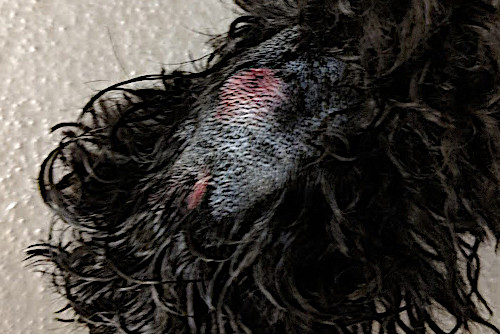Evil Weed: Beware the Foxtail

It's finally stopped raining, and the parks and trails are filled with magnificent wildflower blooms. But along with those gorgeous poppies, lupine, iris, and checkerbloom, danger lurks beneath your dog's paws. The sharp, spiky grasses known as foxtails can cause serious harm to dogs if not treated promptly. Here we'll explore what foxtails are, why they are dangerous to dogs, and how to protect your pet.
Named for its distinctive shape, which resembles a fox's tail, Hordeum jubatum (also known as foxtail barley) is a weed that grows in parks, gardens, along sidewalks, and in city tree wells, fields, and on trails. It thrives in both moist and dry soil, can tolerate a wide range of environmental conditions, and is found nearly everywhere in North America but is most common in the west.
When green and still attached to the stem, foxtails are relatively harmless. But by mid-April, the plant's seed dries up and falls to the ground as the weather grows warmer. Foot traffic helps spread the seeds, as does mowing.
Foxtails are dangerous to dogs for a few reasons. First, the spikes on the grass can quickly become embedded in a dog's skin or fur, causing pain, irritation, and infection. Foxtails are commonly found on a dog's paws, between their toes, or in their ears. If left untreated, a foxtail can cause serious damage.
Foxtails are often difficult to remove once embedded in a dog's skin or fur. This is because the grass's spikes are barbed, meaning they can only move in one direction, making it difficult to pull them out. In some cases, surgery may be required to remove a foxtail.
Embedded foxtails can also cause serious health problems if not removed promptly. Infection is a common complication of foxtail injuries. The spikes on the grass can introduce bacteria into a dog's body, leading to abscesses or even sepsis. In addition, foxtails can travel through a dog's body and cause damage to internal organs. This can be especially dangerous if the foxtail lodges in the dog's throat or lungs.
Frequent and violent sneezing is a sign of a foxtail stuck in a dog's nostrils. Redness and inflammation and licking at paws can indicate a foxtail stuck between foot pads. If a foxtail finds its way into your dog’s ear canal, you might see head shaking, head tilting, and pawing at the ears.

This photo was taken after a late night visit to the emergency vets when a small foxtail got stuck between a pup's toes, went under their skin, and exited out the top of their foot. Photo by Jess.
The best way to protect your dog from foxtails is to avoid areas where they are likely to be found. If you take your dog to a park or other area where grass grows tall, keep them on a leash and stay on the designated paths. Check your dog's fur, paws, and ears for foxtails after every outing, and remove any that you find promptly.
You can also help protect your dog by keeping their fur trimmed short, especially around the paws and ears. This will make it less likely that foxtails will become embedded in their fur.
Booties will protect paws from foxtails, and you may want to consider investing in the Outfox Field Guard, headgear that prevents foxtails from attaching to your dog's eyes, ears, and mouth (designed and sold by Bay Area local Diane Kostelec).
If left untreated, foxtails can harm dogs, causing pain, infection, and even internal damage. Veterinary care for an embedded foxtail can range from a couple hundred dollars (foxtail in the ear without sedation) to around six hundred dollars (foxtail in the nasal passage requiring sedation).
To make matters worse, foxtails do not show up on x-rays, so once embedded, they can be challenging to find and remove. My previous dog had a foxtail embedded in the skin near her belly that required two expensive exploratory surgeries before the vet found the cause of her recurrent abscesses.
As a dog owner, it's essential to be aware of these risks and take steps to protect your pet. By avoiding areas where foxtails are likely to be found, checking your dog's fur, ears, and paws regularly, and keeping their fur trimmed short, you can help keep your furry friend safe and healthy from this evil weed.

